| Top Hats |

Original Stove Pipe Hat |
.
The top hat originates to the beginning of the nineteenth
century. Primarily made of beaver felt, the top hat evolved into many different
heights and styles throughout its two hundred year history. Top hats are
currently made from fur felts, silk, and wool felts. During the middle
part of the nineteenth century it became fashionable to wear a silk top
hat, which caused the decline of the beaver trade in the United States.
Silk top hats also became collapsible, allowing a gentleman to store it
in his coattail while attending the opera.
Top hats are worn today for formal and special occasions,
but they used to be everyday toppers during the eighteenth century. The
"derby hat" surpassed the top hat in popularity during the late nineteenth
century as everyday wear. Perhaps the most recognized style of top hat
was the one worn by Abraham Lincoln, who used to store his papers and wallet
in his hat. Abraham Lincolnís top hat was so tall that in the summer of
1862 a would-be assassin missed his head and shot a hole through his top
hat.
Top Hat styles of the 1800's

Wool Top Hats |

New York Top Hat |

The Coachman |

Stove Pipe Hat |
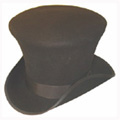
English Mad Hatter |
|
| Derby and Bowler Hats |
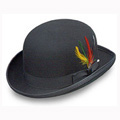 |
The bowler or derby hat was introduced in the 1850ís. The
derby hats importance is that it was worn by virtually every class of society.
This is the first hat credited for being mass produced and priced to meet
everyone's budget. The derby hat replaced the top hat in the late nineteenth
century as the most popular hat for men, and remained popular for almost
seventy years until their decline in the 1920ís to the fedora.
The derby hat came in many different styles from the low-crown
to the stingy brim. The bowler started out as a protective hat for coachmen
and gamekeepers. They were stiffened and protected against branches and
other obstacles, while riding on horses. Eventually the derby style caught
on and became fashionable. The term Bowler is an English name for the hat.
The Americans started calling the hat a derby when the Earl of Derby wore
the hat at the Derby races. |
| The Cowboy Hat |
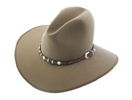 |
.
The son of a Philadelphia hat maker created the first
cowboy hat in 1865. His name was John B. Stetson, now known as the
inventor of the cowboy hat.
As the story goes, John B. Stetson and some companions
went west to seek the benefits of a drier climate. During a hunting
trip, Stetson amused his friends by showing them how he could make cloth
out of fur without weaving. Stetson used the fur from hides collected
on the hunting trip. Kneading the fur and working it with his hands,
dipping it into boiling water, spreading it out, kneading it, and dipping
it again, he created a soft, smooth piece of felt. Using a technique
that has been known since the beginning of modern civilization, Stetson
amazed his friends by using the only material he had at hand--fur.
Stetson made a unusually large hat out of this fur-felt.
He then wore the hat for the remainder of his hunting trip. Although initially
worn as a joke, Stetson soon grew fond of the hat for its ability to protect
its wearer from the elements. It had a wide brim for protection from the
elements, a high crown to keep an insulating pocket of air on the head,
and a waterproof lining so the hat could be used to carry water. He and
other cowboys of the west ended up liking the idea so well that Stetson
soon manufactured and sold a hat true to his original idea. Since
his hunting trip, J.B. Stetson intended his new hat creation to be for
the cowboys that he came to know in the west. Thus, the creation of the
first cowboy hat.
The hat was first sold in Central City, Colorado in 1865
under the name "Boss of the Plains," more commonly known as the "ten-gallon
cowboy hat". Later, Stetson's cowboy hat was renamed the "Stetson", after
its inventor.
.
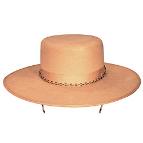
"Boss of the Plains" |
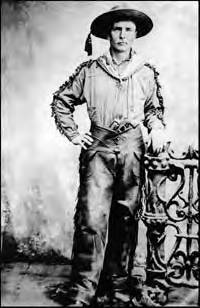 |
.
In 1869 Stetson returned to Philadelphia to found his
hat company, which produced high quality hats for outdoors use. By 1886
Stetson's hat company was the largest in the world, and had mechanized
the hat-making industry.
The term "Ten Gallon Hat" is the result of a linguistic
mix-up. "Galón" is the Spanish word for "braid." Some vaqueros wore
as many as ten braided hatbands on their sombreros, and those were called
"ten galón hats." English speakers heard gallon.
|